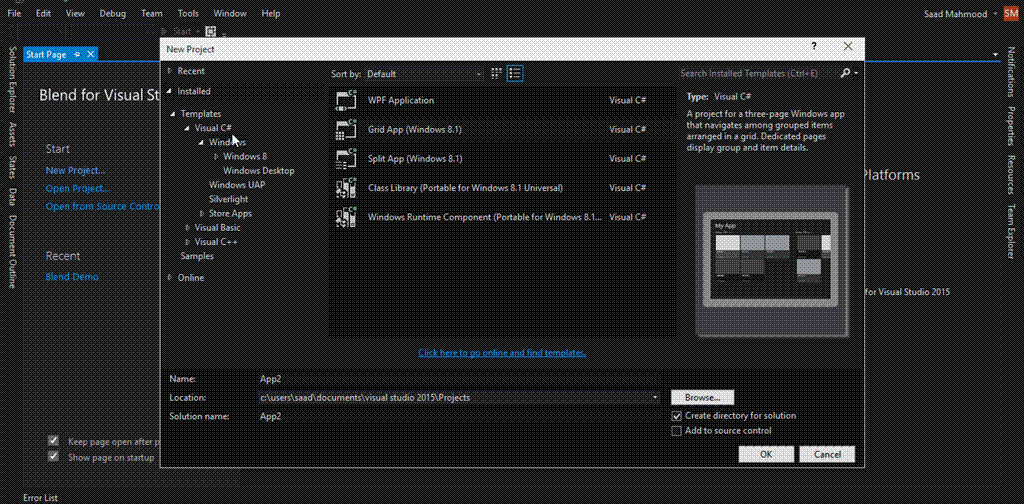

- #EXPRESSION BLEND DOWNLOAD FOR VISUAL STUDIO 2010 CODE#
- #EXPRESSION BLEND DOWNLOAD FOR VISUAL STUDIO 2010 TRIAL#
- #EXPRESSION BLEND DOWNLOAD FOR VISUAL STUDIO 2010 WINDOWS 7#
Įxpression Blend 4 Release Candidate (RC) is available for download here.
#EXPRESSION BLEND DOWNLOAD FOR VISUAL STUDIO 2010 WINDOWS 7#
The Visual Studio 2010 Theme for Windows 7 is available for download here.
#EXPRESSION BLEND DOWNLOAD FOR VISUAL STUDIO 2010 TRIAL#
All the downloads come as free versions, trial releases for VS2010, and can be tested immediately. You will be able to find download links at the end of this article. NET 4 and Silverlight 4 also have a new Build, the Release Candidate of Expression Blend 4 available. NET 4 was Silverlight 4, released the past week. Starting with April 12, 2010, Microsoft has been offering developers the chance to download the RTM versions of both Visual Studio 2010 and. I also changed the default picture position to Center,” Caron explained. This one is a bit larger to work with a wider variety of resolutions. “Based on feedback and my own need for a theme that'll work for a widescreen and a portrait-oriented monitor, I created another theme. The background images use the platform’s visual identity, along with the official logo and designs. The overhauled theme now comes with additional content, as well as extra options to help with the desktop personalization for those that have Visual Studio at heart. However, it appears that Caron was not content with the original version of the VS2010 Windows 7 theme, and refreshed it. The VS2010 theme for Windows 7 was initially released on April 11, 2010, just as the Redmond-based company had announced the imminent launch of Visual Studio 2010 RTM and. Some of you might already be familiar with the Visual Studio 2010 theme put together by Rob Caron, the Marketing Communications Manager for Developer and User Experience Runtimes and Tools at Microsoft. But if you don’t understand something in this syntax, let me know and I’ll include more information in the documentation.ĭocumentation for this feature is now availabe on MSDN: Debugging Expression Trees.An updated version of a theme focused on the latest iteration of Microsoft’s development platform is now available for download.

There are some other nuances that I think are evident and don’t need additional explanation. For example, the checked addition operator is displayed as #+. Checked operators are displayed with the # symbol preceding the operator.If a parameter, label, or lambda expression does not have a name, the name is generated automatically (for example, #Label1, $var1, etc.).(For example, for decimal the value is 1M, for double 1D, etc.) For other numeric types that have standard suffixes, the suffix is added to the value. Integer, string, and null constants are displayed “as is” (for example, $result = 1).Parameters are displayed with a $ symbol at the beginning (for example, $result and $value.).There are some simple rules used in this metalanguage: (No, we couldn’t use C# here, because expression trees serve other languages as well.) Now click Text Visualizer and you get this.Īs you can see, the content of the expression tree is represented in some kind of metalanguage. Click the magnifying glass icon and you will see the list of available visualizers. But it’s used to hook up the expression trees visualizer. This property is private and is exposed only in the debugger, so you can’t use it in your code. Rest the mouse pointer over the lambda variable and you will see that it has the DebugView property.
#EXPRESSION BLEND DOWNLOAD FOR VISUAL STUDIO 2010 CODE#
This gives you a good understanding of the tree structure, but it might be hard to understand the actual content of the tree.īut there is a better solution: expression trees now have their own visualizer that helps you to explore their structure and content.Ĭopy the above code example into Visual Studio 2010, set a breakpoint at the last line, and press F5. However, since this is a tree, you need to click through numerous nodes. Basically, it tells you only that the lambda has the result parameter.Īnother option is to explore the tree structure in the Watch window. Now, what if you want to see the content of this tree in debug mode? You can try lambda.ToString() but it’s not very informative.

LabelTarget label = Expression.Label( typeof( int)) īlockExpression block = Expression.Block(Įxpression.Assign(result, Expression.Constant( 1)),

ParameterExpression value =Įxpression.Parameter( typeof( int), "value") Įxpression.Parameter( typeof( int), "result") It creates an expression tree for calculating the factorial of a number. First of all, let’s take a look at the example from one of my previous posts.


 0 kommentar(er)
0 kommentar(er)
